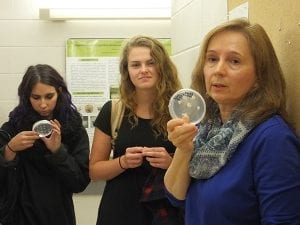News
Van Eck Gives Insight into Genetic Engineering to Cornell Students
Students in Cornell University’s course, The GMO Debate: Science and Society, received a behind-the-scenes look at the inner workings of a genetic engineering laboratory at Boyce Thompson Institute, courtesy of Assistant Professor Joyce Van Eck and postdoctoral researcher Alex Amaro.
After giving an overview of the techniques that plant scientists use to insert new genes into plants, Van Eck showed plates and test tubes with genetically engineered plants and gave a tour of her lab. Amaro demonstrated the “gene gun,” a device that shoots DNA-coated particles into plant cells to deliver new genes, which Cornell horticulture professor John Sanford invented in the 1980s. This is the second year that students from the course have visited BTI, and the tour is the only lab-based component of the class.
Professor Peter Davies of the Horticulture section of the School of Integrative Plant Science is one of the five teachers of the interdisciplinary course. He invited Van Eck as a guest lecturer to give the students a taste of the actual techniques that plant researchers employ to genetically enhance food crops. The students come from a broad range of backgrounds, ranging from animal science to government, and some have had little contact with scientists.
“We wanted the students to see the actual process,” said Davies. “In the lectures, they get the theory but many of them have absolutely no idea of how things are actually done. In fact, if you go on the web, what you see is all these pictures of mad scientists with syringes,” he said. “Some of them, that’s all they’ve seen.”
Van Eck and Amaro’s demonstrations were well received by the students.
“I learned a lot about how the process actually works in practice,” said Owen Beuhler, a senior computer science major with an interest in biology. “I’m a computer engineer and find genetics pretty interesting because it’s a lot like computer code, but in a different format.”
As part of the tour, Van Eck passed around tissue culture plates showing plant specimens that her lab had “transformed,” meaning that they had inserted a new gene. Her lab mainly uses a bacterium called Agrobacterium tumefaciens, which, in the wild, has the ability to transfer DNA to plant cells to engineer them to produce metabolites necessary for bacterial growth.
“About 30 years ago, scientists had the idea to isolate the bacterium from the soil and try it in the lab to see if they could do genetic engineering with genes that were of interest to them,” said Van Eck. “That was the whole start of plant transformation.”



